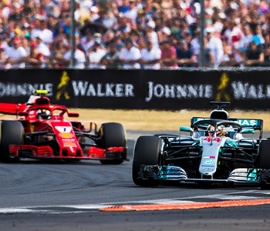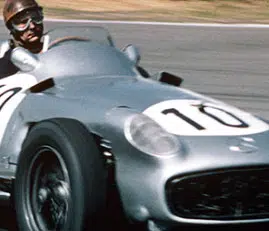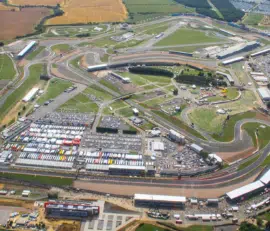An entry of 55 was received, ranging in power and speed from D-type Jaguars and 300SLR Mercedes-Benz to 900-c.c. D.K.W. and 750-cc. Panhards. Having full works support the cream of Grand Prix and sports-car drivers were competing, among the top being such names as Hawthorn, Fangio, Moss, Musso, Castellotti, Taruffi, Maglioli, Kling, Collins, Salvadori, Walker and Parnell, and among the bottom were comparative novices, whose feelings must be considered so no names will be mentioned, and the in-between class contained most of the regular sports-car drivers from home and abroad. A study of the narrow and highly exacting Dundrod circuit, where there is no room for a single mistake to be made and bad driving stands out like a sore thumb, together with the entry list should have caused many of the entries to be withdrawn on the spot, either for lack of performance of the cars, or lack of experience of the drivers, but none were brave enough to admit of such weaknesses. As a result the Thursday afternoon practice found the really fast boys muttering dark things about the "traffic" on the course, and difficulties of trying to get past certain ill-mannered slow drivers. It was the old story, popular wherever organisers accept entries from every Tom, Dick and Harry, and continue to insist on running 170-m.p.h. cars at the same time as 100-m.p.h cars, a problem a hundred times more critical on such a tough course as Dundrod, which is a circuit that is difficult for Grand Prix drivers, let alone novices. The essence of sports-car racing seems to be that it allows class racing as well as a general classification and this is all right up to a point, but it is high time that the particular point was clarified. There is no justification in these days of high speed to allow a difference in lap speed of 10 m.p.h. between the fastest and the slowest IN ANY GIVEN GLASS.
The Continental invasion of the Dundrod circuit was the best yet, consisting of three works Ferraris, with Castellotti, Taruffi, Trintignant, Maglioli, Gendebien and Gregory as drivers; three Mercedes-Benz with Fangio, Moss, Kling, Simon, Fitch and von Trips to choose from, and two 3-litre Maseratis with Behra, Musso, Bordoni and Musy as drivers. Against these and some private Continental entries in the big classes Jaguar pitted one factory car with Hawthorn and Titterington as the drivers, while Aston Martin fielded their full team of DB3S cars, driven by Collins/Brooks, Parnell/Salvadori, and Walker/Poore. There was a team of factory Porsche Spyders, an official B.M.C. team of M.G.s, a team of French DBs and numerous English small cars such as Lotus, Connaught, Cooper and Kieft.
Ferrari had all three cars out for practice, two being 3-litre Monza models and the third an enlarged Monza of 3.4 litres, though this was giving trouble and blowing out clouds of smoke. One of the 3-litres was completely written off when the Belgian driver Gendebieu crashed at Wheeler's Corner, sustaining a broken arm, and as a consequence the co-driver, Masten Gregory, was loaned to Porsche for their official team. Mercedes-Benz had three new 300SLR models, basically the same as at Le Mans but without the air-brake, while the drivers had two training cars to play with. One was an old Le Mans car, with air-brake, and the other the coupé model described last month in Motor Sport. Contrary to daily paper stories this coupé did not arrive in a sealed crate as a closely-guarded secret, but was actually the works hack, being driven by road from Stuttgart by von Trips, to give him a chance to become accustomed to the 300SLR as the Ulster T.T. was to be his first appearance in the Rennsportwagens. During the practice this coupé proved useful as Moss broke his car on the far side of the circuit and Kling was able to give him a lift back to the pits in the comfortable two-seater cockpit. Also Fangio and Kling were a bit naughty in going round together to discuss the circuit in the comfort of this coupé, and it evoked cries of protest from Jaguar's team manager on the score of "regulations" but it sounded much more like "sour grapes" when looking at the passenger's seat in the D-type. That the 1955 Ulster T.T. was going to be a classic event was shown by the serious way most of the teams arrived prepared for any emergency, there being spare Jaguars, Aston Martins and M G.s on hand as well as numerous engines. The first practice afternoon managed to stay dry throughout, but on the second day Northern Ireland did its best to discourage the visitors and conditions ranged from "full wet" to "full dry" and most of the time was spent watching the good drivers show how well they could drive and the bad ones making, it even more obvious that in the interests of human safety they should have packed up and gone home. Observing at most of the corners on the mountainous circuit, thanks to an excellent system of lanes in the centre of the circuit, it became more and more obvious that the time is rapidly approaching for either the abolition of sports-car racing and the substitution of Formula II and Formula IV class racing, or some pretty serious weeding out of entries and sub-divisions.





